Connecticut Documents
Quitclaim Deed
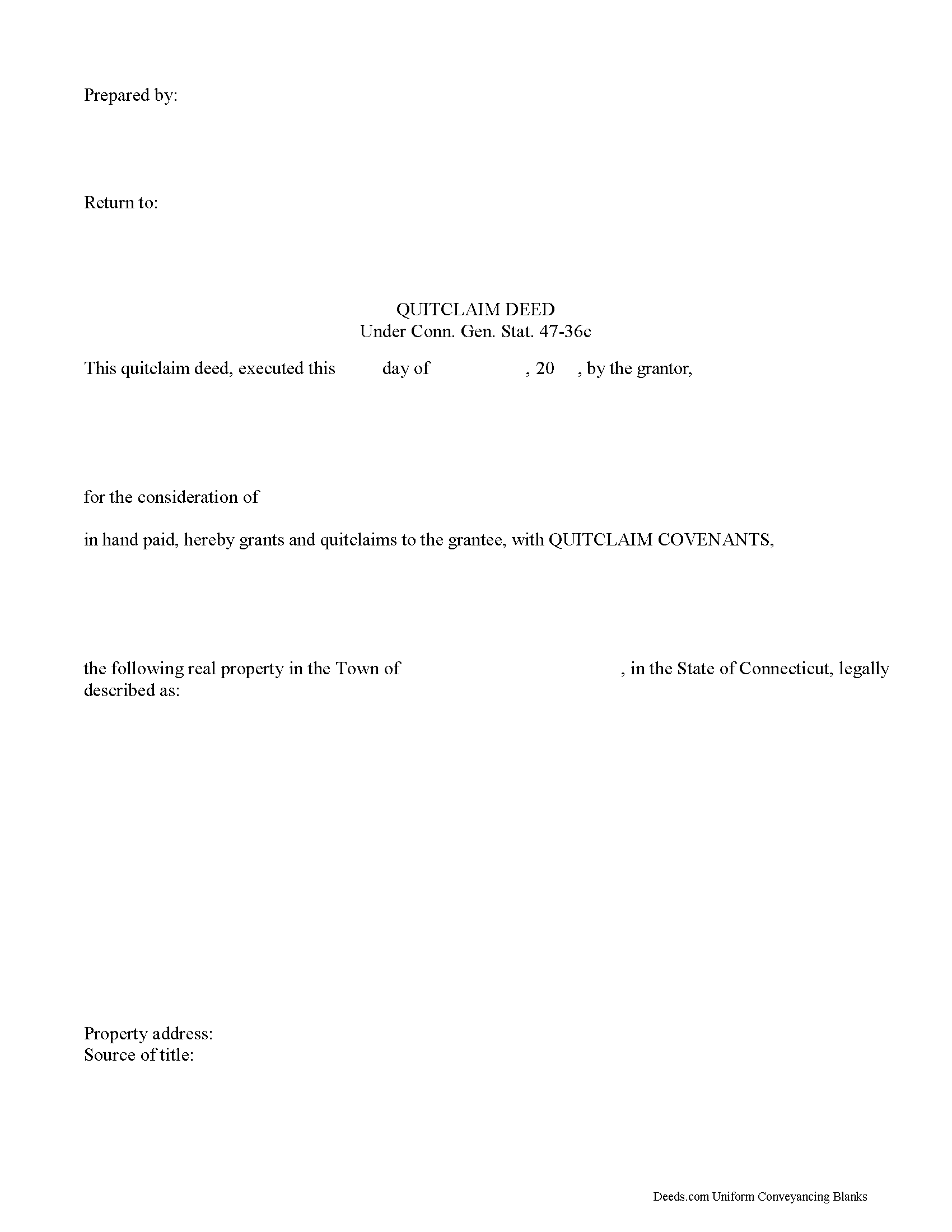
As set forth in General Statutes Sec. 47-5, 47-36c, quitclaim deeds in the state of Connecticut must contain specific information in order to be validly executed.
Contents:
Lawful quitclaim deeds must be in writing; require a title clearly identifying the purpose of the document; the names and addresses of both grantor and grantee; the grantee's vesting choice (how he/she wishes to hold title); a legal description and address of the real property conveyed; the date of execution and signing; the grantor's signature; acknowledgement of notary or other officer certified to administer oaths; and signatures of two witnesses not named on the deed, one of whom may be the notary (47-5, 47-10). In addition, any document that changes the information contained within a previously recorded document must contain the book and page or serial number reference of the prior recording as well as the name and contact information of the person who created the new legal description. (See 38-35-106.5)
Recording:
Record all documents marking a change in land ownership in the office of the Town Clerk or other official responsible for maintaining the public land records. 7-24 defines statutory for... More Information about the Connecticut Quitclaim Deed
Gift Deed
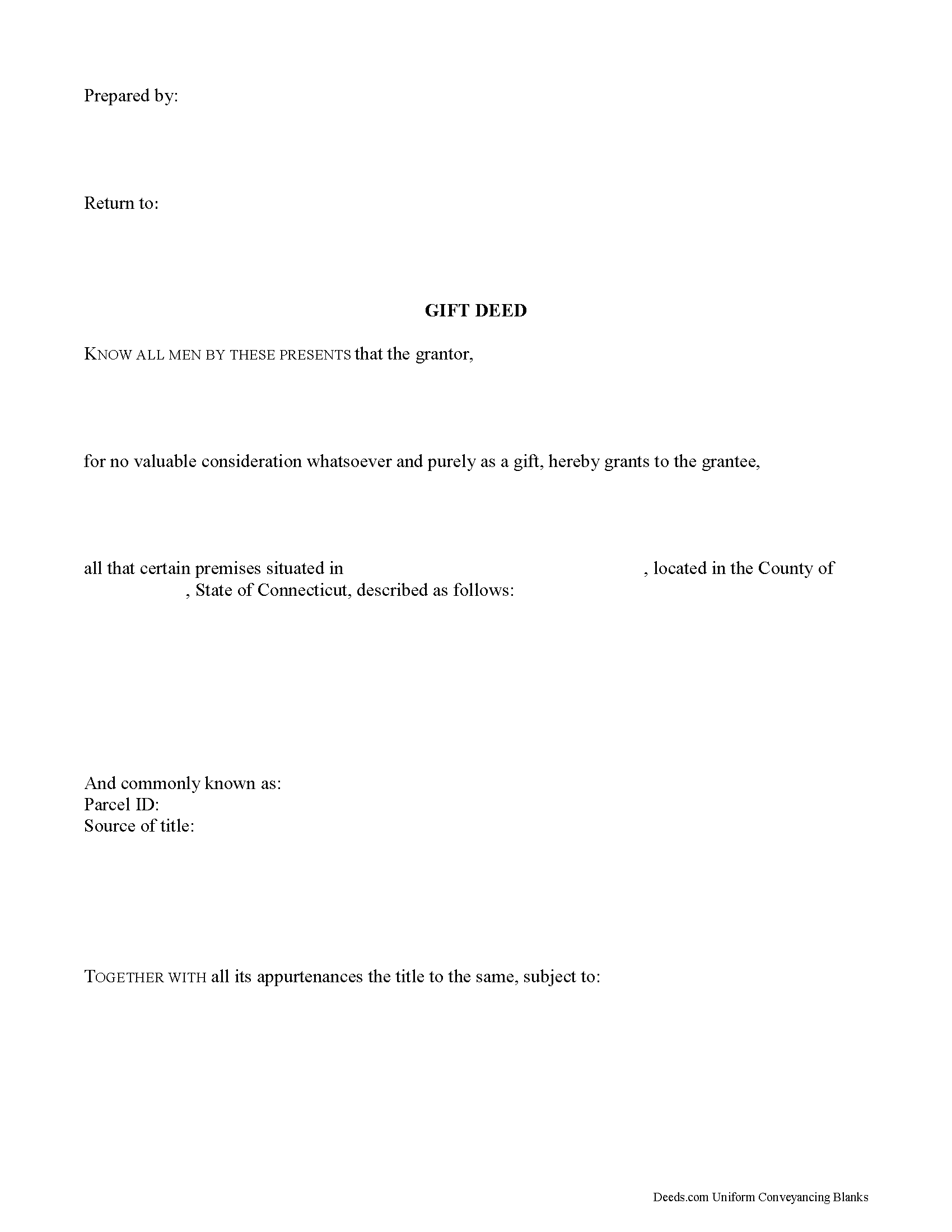
Gift deeds convey title to real property from one party to another with no exchange of consideration, monetary or otherwise. Often used to transfer property between family members or to gift property as a charitable act or donation, these conveyances occur during the grantor's lifetime. Gift deeds must contain language that explicitly states that no consideration is expected or required. Ambiguous language, or references to any type of consideration, can make the gift deed contestable in court.
A lawful gift deed includes the grantor's full name and marital status, as well as the grantee's full name, marital status, vesting, and mailing address. Vesting describes how the grantee holds title to the property. Generally, real property is owned in either sole ownership or in co-ownership. For Connecticut residential property, the primary methods for holding title in co-ownership are tenancy in common and joint tenancy. An estate conveyed to two or more people is presumed a tenancy in common, unless a joint tenancy is clearly specified (Conn. Gen. Stat. 47-14(a)). The primary characteristic of joint tenancy is the right of survivorship. In Connecticut, when joint tenancy is declared... More Information about the Connecticut Gift Deed
Warranty Deed
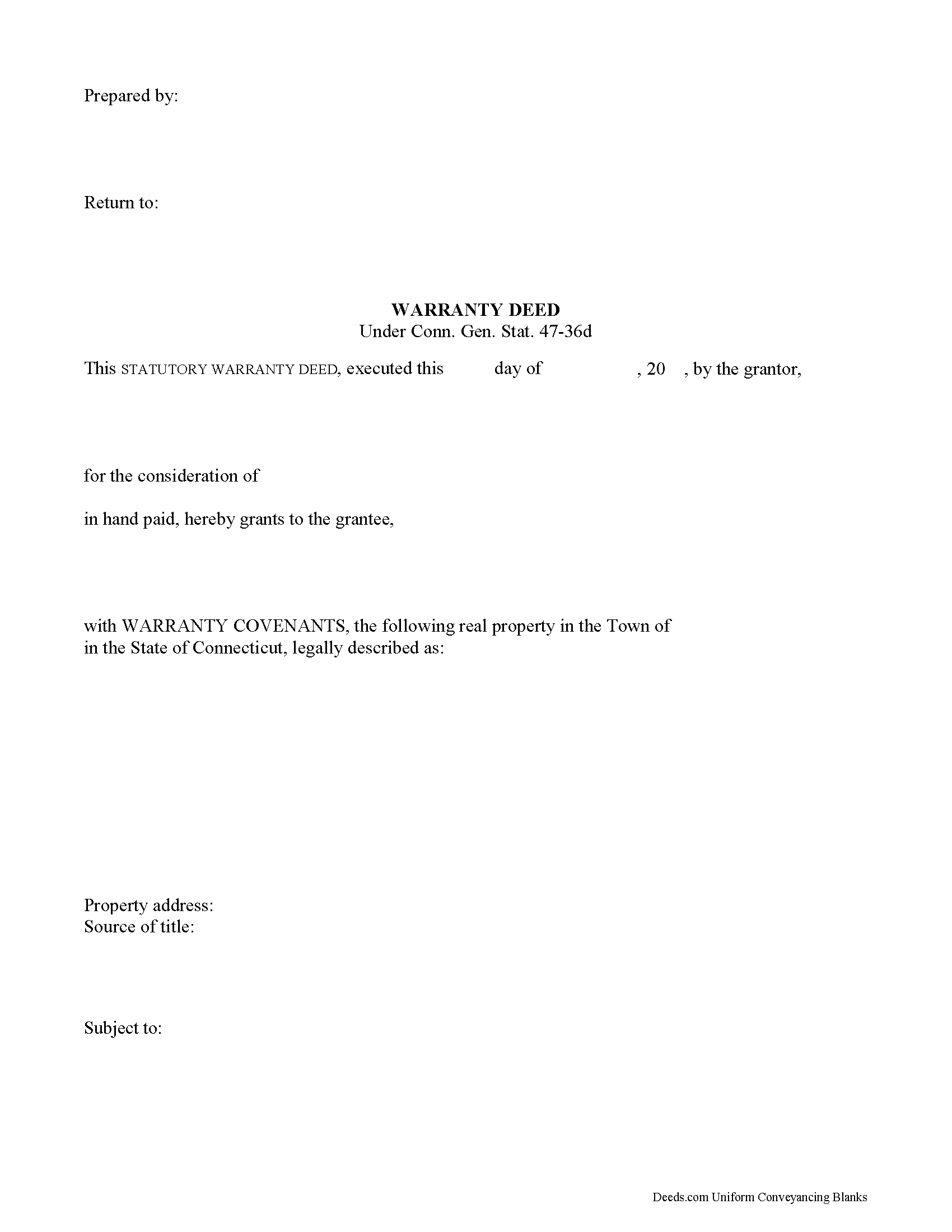
All conveyances of land in Connecticut must be in writing, subscribed by the grantor with or without a seal, or by his/her attorney authorized for that purpose, acknowledged and witnessed in the manner provided by law for conveyances (sec 47-5).
The forms set forth in 47-36c of the Connecticut Statutes can be used for a conveyance of real property in this state. However, the inclusion of these forms in the statutes does not prohibit the use of other deed forms. In a warranty deed, the use of the words "with warranty covenants" has the force, meaning, and effect of the following covenants: (1) that at the time the deed was delivered, the grantor was seized in fee simple of the granted premises; (2) that the granted premises are free from all encumbrances, except as may be set forth in the deed; (3) that the grantor has good right, full power, and lawful authority to sell and convey the same to the grantee; and (4) that the grantor, his heirs, executors, and administrators will warrant and defend the granted premises to the grantee and his assigns forever against the claims and demands of all persons, except as may be set forth in the warranty deed (47-36d).
If a warranty deed... More Information about the Connecticut Warranty Deed
Special Warranty Deed
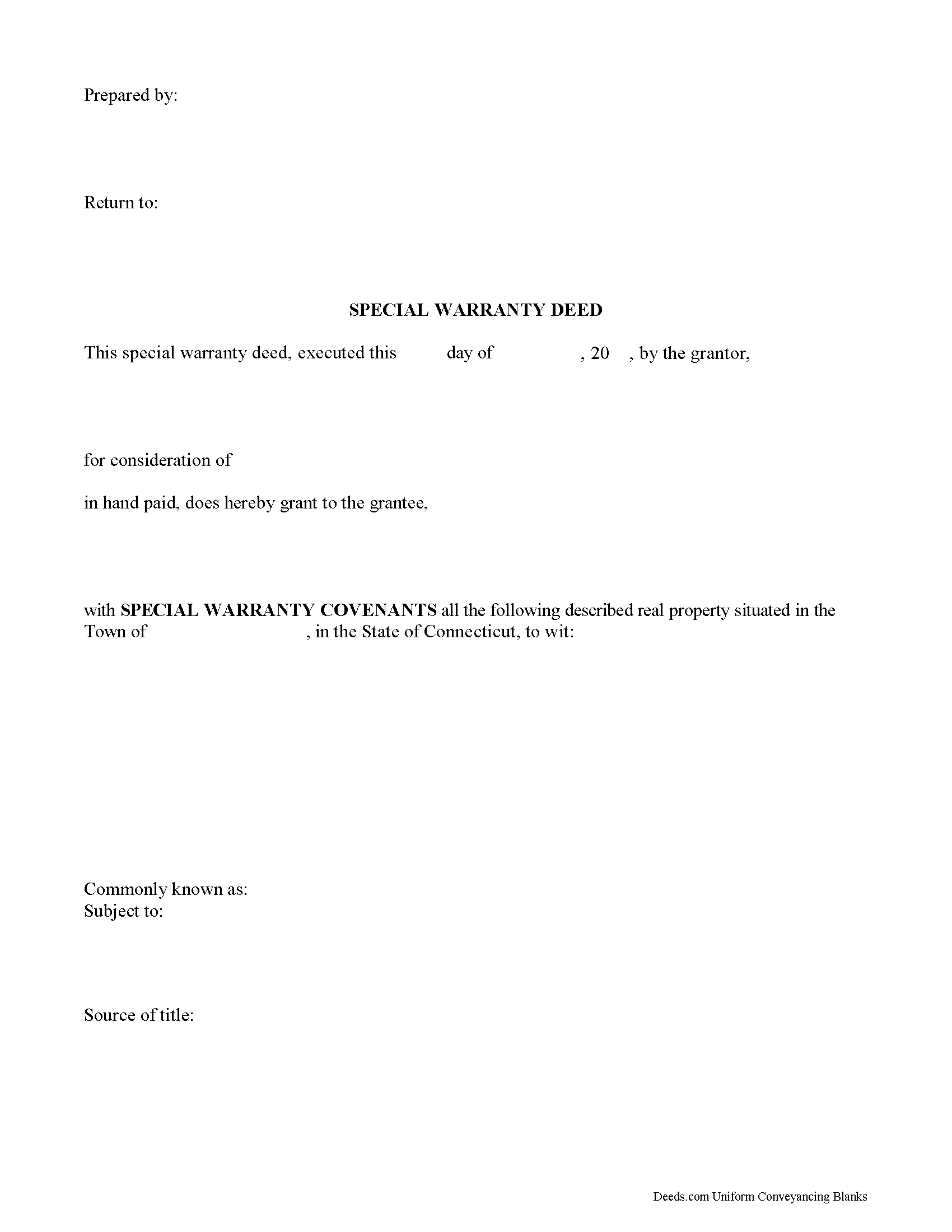
A special warranty deed, with limited warranty covenants, can be used to convey title to real estate in Connecticut. This form must meet the statutory requirements for a conveyance of real estate in Connecticut.
The Connecticut General Statutes do not specifically address special warranty deeds by name. However, section 47-36c provides statutory forms for conveyances and also states that "nothing in this chapter precludes the use of any other legal form of deed or mortgage." A duly executed special warranty deed should contain the following covenants of warranty: (1) that at the time of delivery of the deed, the grantor is lawfully seized in fee simple of the granted premises, (2) that the granted premises are free from all encumbrances, except as set forth in the deed, (3) that the grantor has good right, full power, and lawful authority to convey the same to the grantee, and (4) that the grantor and his heirs, executors and administrators will warrant and defend the granted premises to the grantee and his assigns forever against the claims and demands of all persons claiming or to claim by, through, or under the grantor.
A special warranty deed must be signed and acknowle... More Information about the Connecticut Special Warranty Deed
Grant Deed
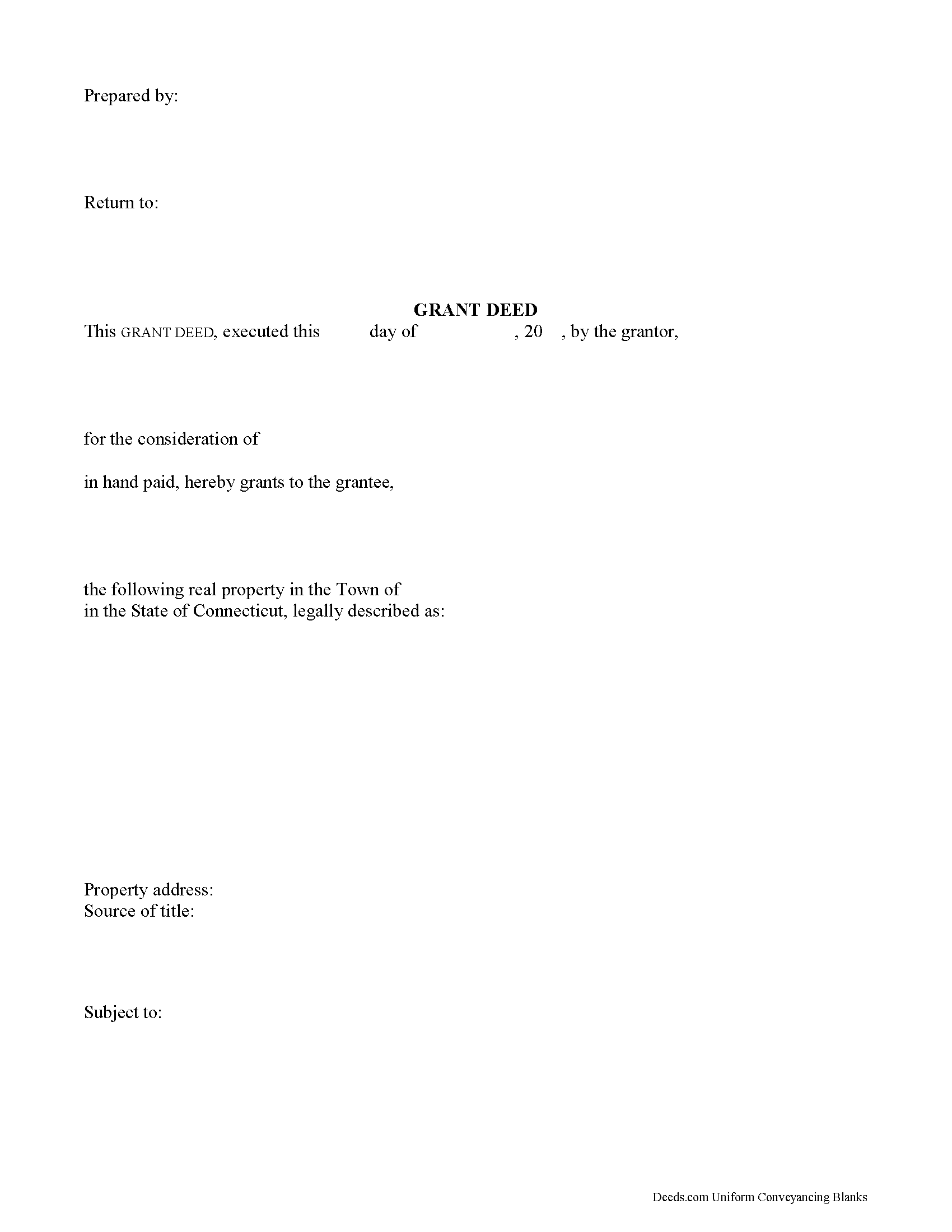
The list of Connecticut statutory forms of deeds (section 47-36c) does not include a form for a grant deed. However, the list of forms provided by statute does not preclude the use of any other type of legal deed. Grant deeds may also be referred to as special or limited warranty deeds in this state.
A grant deed transfers real property in Connecticut from one person or entity to another person or entity. Grant deeds warrant that the grantor actually owned the title that he or she is purporting to transfer. It guarantees that the property has not been sold to anyone else, and also that the property is not under any liens or restrictions that have not already been disclosed to the buyer.
The grantor to a grant deed in this state must sign the conveyance document and have his or her signature acknowledged. If acknowledged in Connecticut, acknowledgements can be made before a judge of a court of record, a clerk or commissioner of the Superior Court, a justice of the peace, a notary public, or a town clerk (47-5a). If acknowledged in a state other than Connecticut, acknowledgements may be made before any of the officers listed in 47-5a. Grant deeds executed out of state will be... More Information about the Connecticut Grant Deed
Correction Deed
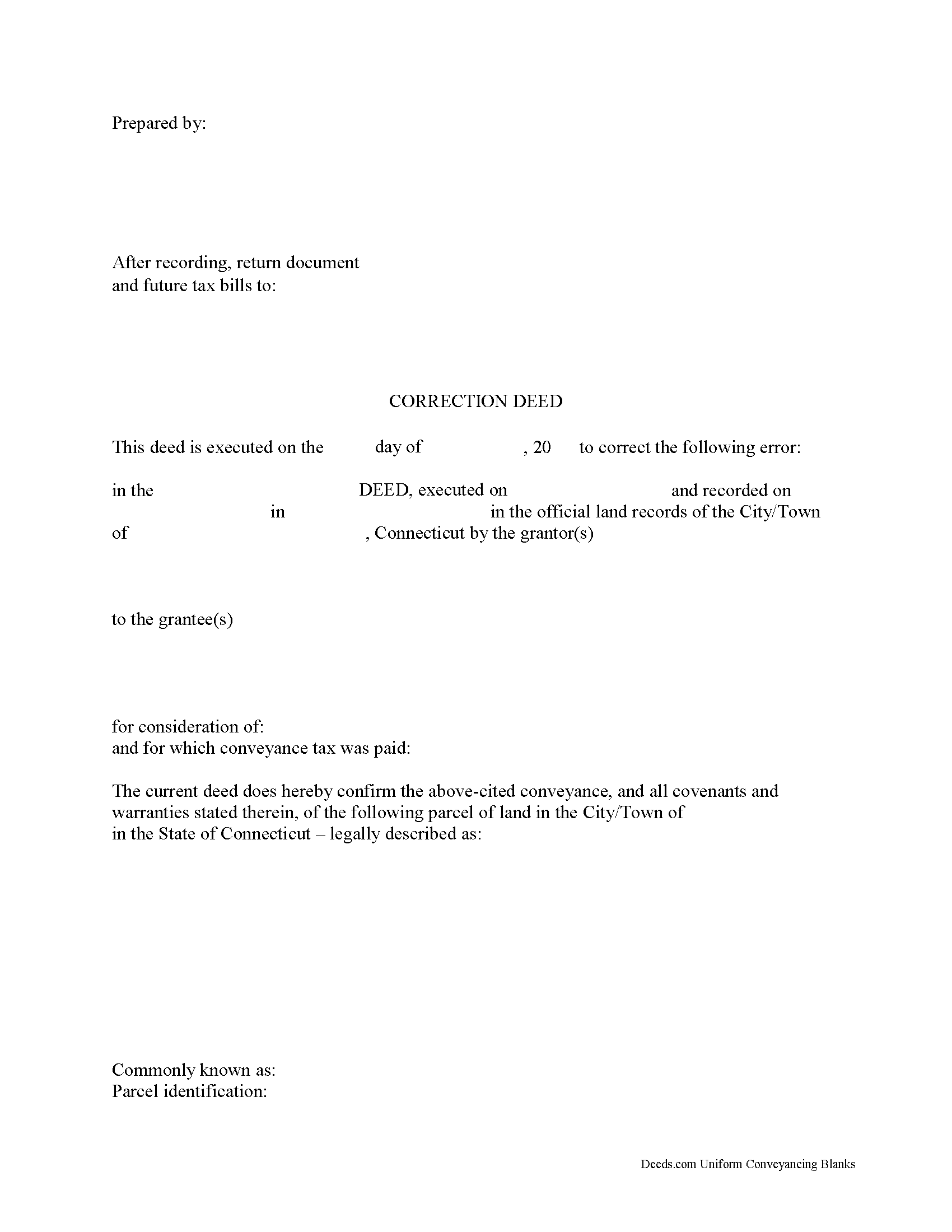
Use the correction deed to amend a previously recorded warranty, special warranty, or quitclaim deed with an error that could affect future title transfer.
A corrective deed is, in effect, an explanation and correction of an error in a prior instrument. As such, it passes no title, but only reiterates and confirms the prior conveyance. It should be executed from the original grantor to the original grantee, and it needs to be recorded in order to be legally valid.
The correction deed must reference the original conveyance it is correcting by type of error, date of execution and recording, and recording number and location. Beyond that, it restates the information given in the prior deed, thus serving as its de facto replacement. The prior deed, which constitutes the actual conveyance of title, remains on record and will receive a marginal cross reference to the correction on record..
Deeds of correction are most appropriate for minor errors and omissions in the original deed, such as misspelled names, omission of marital status, or typos in the legal description. More substantial changes, such as adding a name to the title or adding/subtracting a portion of land to the l... More Information about the Connecticut Correction Deed
Easement Deed
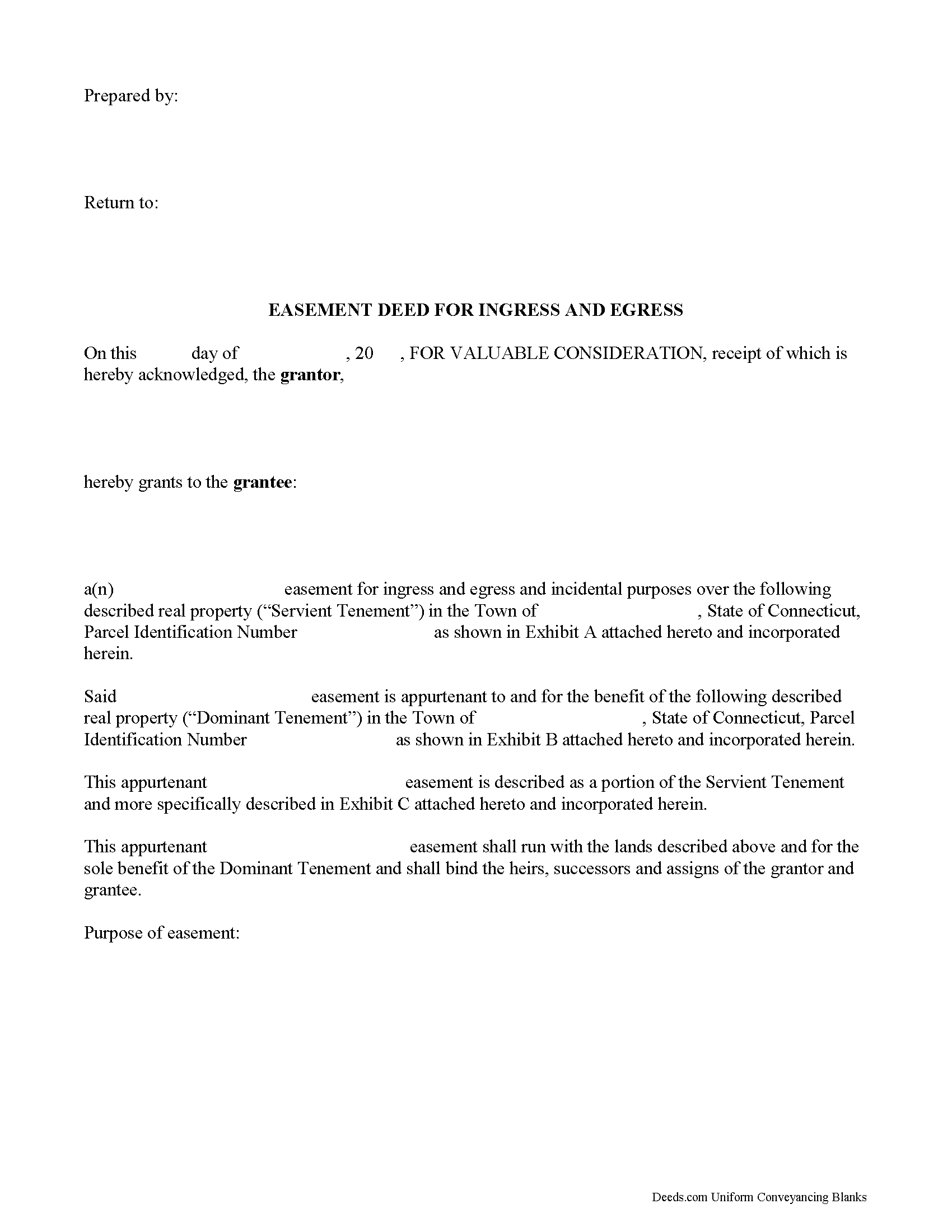
An easement is the right to use another person's property for a specific purpose. It is a non-possessory interest in another person's land. There are many forms of easements, such as utility easements and right of ways.
An easement or right-of-way in Connecticut may not be acquired from, in, upon, or over the land of another by the adverse use or enjoyment thereof unless the use has continued uninterrupted for fifteen years (47-37). The owner of land over which an easement or other right of way is claimed or used may give notice in writing to the person claiming or using the privilege, of his intention to dispute the right of way or other easement and to prevent the other party from acquiring the right. The notice, once served and recorded, is deemed an interruption of the use and will prevent the acquisition of a right thereto by the continuance of the use for any length of time thereafter (47-38).
As an instrument that affects real property, an easement should be executed and acknowledged according to the rules of all other conveyances of real property in Connecticut. The grantor, or the person granting the easement, should sign the form and should have his or her signatur... More Information about the Connecticut Easement Deed
Termination of Easement / Right of Way / Access to and From
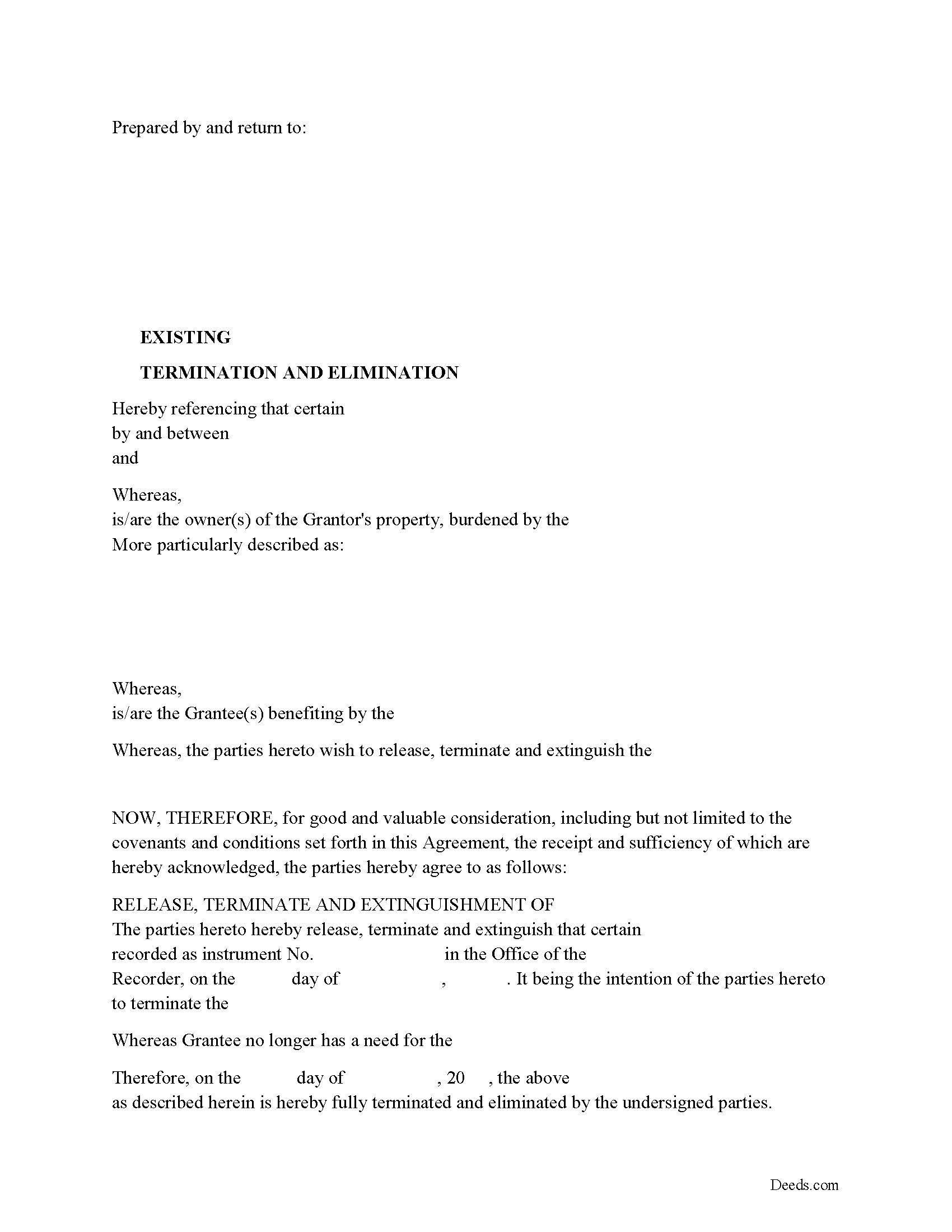
Use this form to release, terminate, extinguish a previously recorded document that involves access to and from a property.
Documents such as:
1. Easement Deeds or Agreements (An easement is a non-possessory interest in land, granting the right to use someone else's property for a specific purpose, like a driveway or utility line)
2. Access Roads
3. Right of Ways
4. Utility Easements (Power, Gas, Water, Sewer, Etc.)
5. Drainage Easements
This document allows the owner of the land, burdened by the access and the party that benefits from the access, to sign an agreement releasing the property from such access, ... More Information about the Connecticut Termination of Easement / Right of Way / Access to and From
Executor Deed
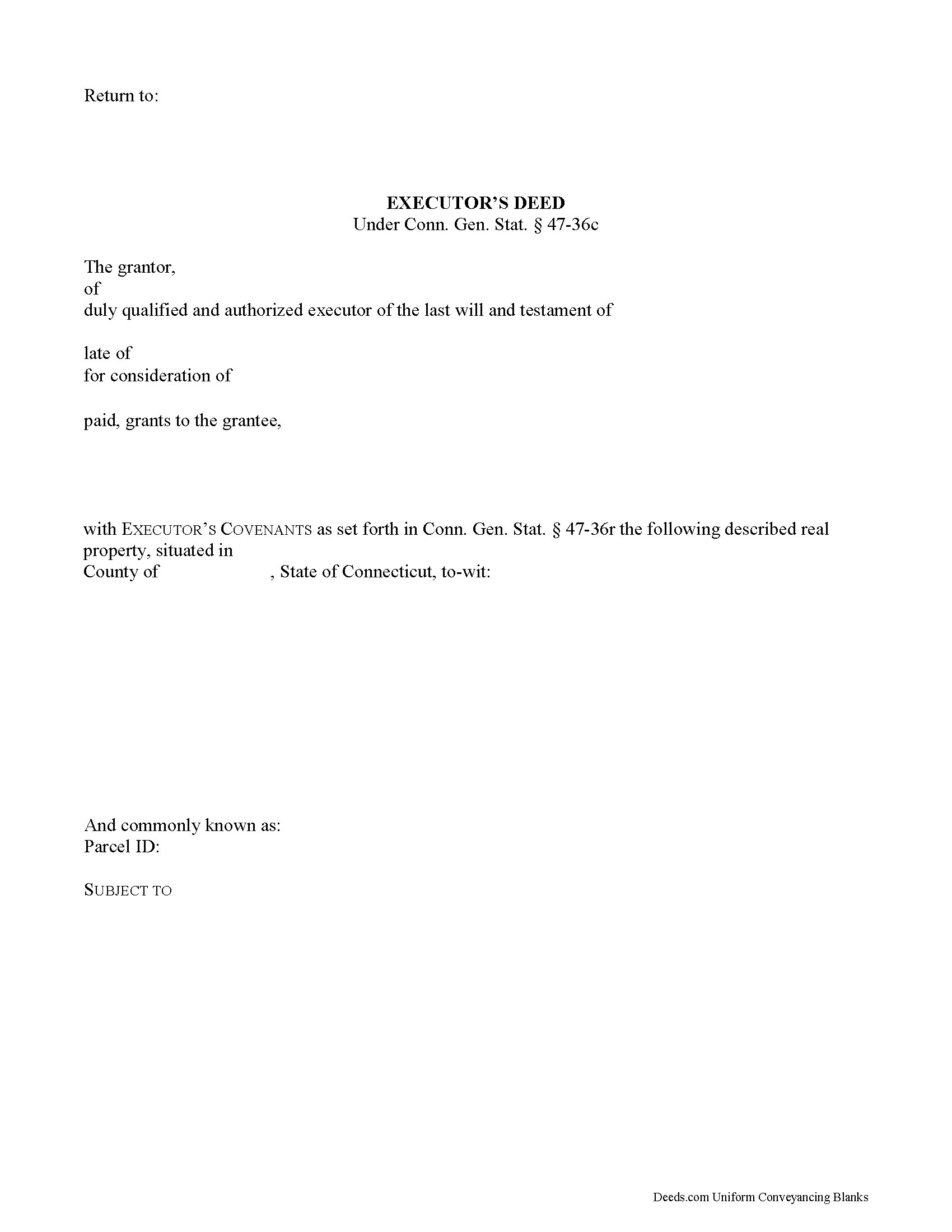
As part of the probate process, a personal representative's duties include transferring a decedent's real property to those entitled to receive it. A personal representative may also sell real property in order to pay the estate's debts.
An executor is a personal representative designated by a decedent's will to settle the decedent's estate. Use an executor's deed to convey fee simple title to a grantee, who is either a beneficiary, heir, or buyer.
The deed contains covenants that the grantor is qualified to act as executor of the decedent's estate; is authorized to bargain and sell the property pursuant to the terms of the decedent's will or by order of the probate court; and will warrant and defend the grantee's title against the claims of persons by, from, or under the grantor.
Contact an attorney with questions about executor's deeds or any other issue related to probate in Connecticut.... More Information about the Connecticut Executor Deed
Administrator Deed
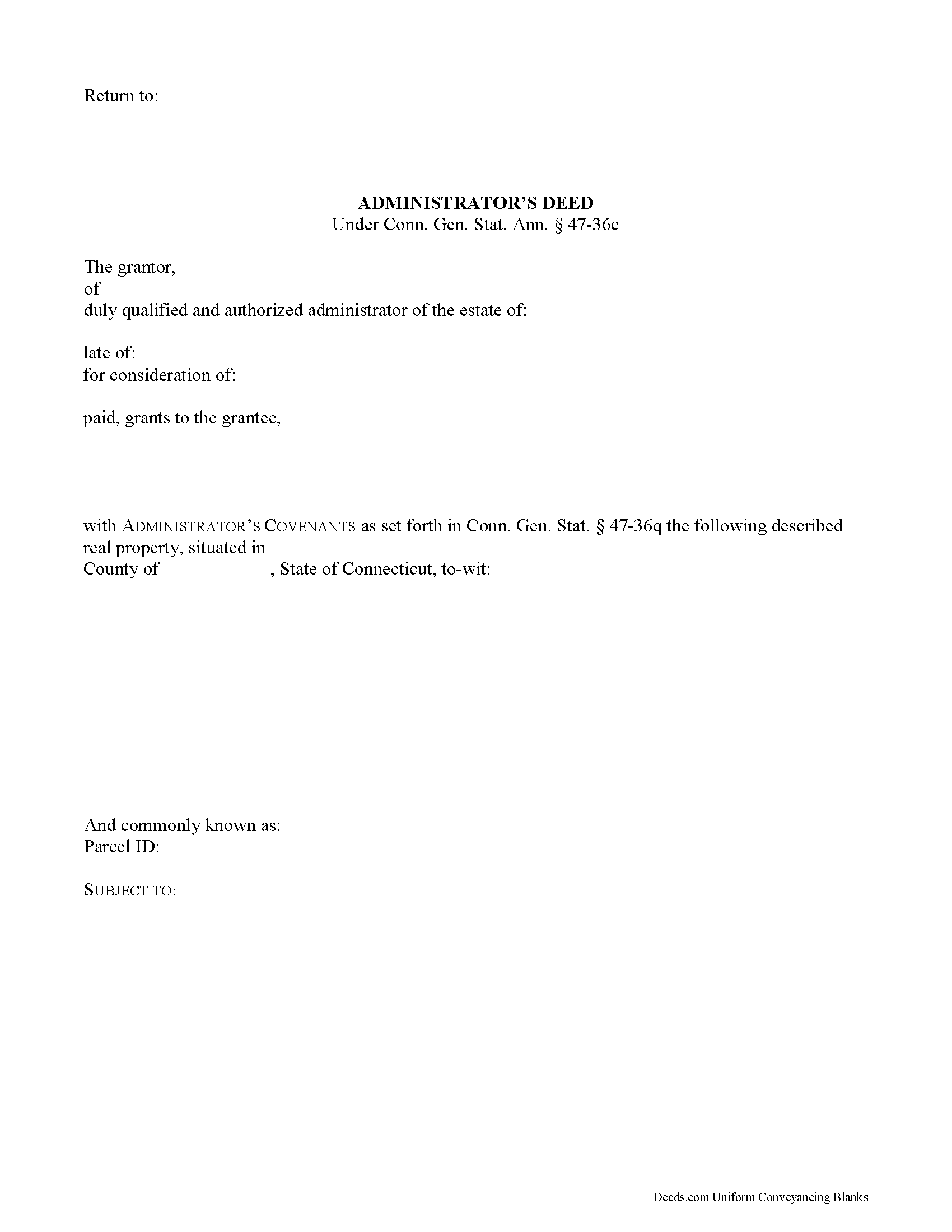
As part of the probate process, a personal representative's duties include transferring a decedent's real property to those entitled to receive it. A personal representative may also sell real property in order to pay the estate's debts.
An administrator is a personal representative designated by the probate court to settle the decedent's estate when the decedent has died intestate (without a will), or has failed to name an executor in a will. Use an administrator's deed to convey fee simple title to a grantee, who is either a beneficiary, heir, or buyer).
The deed contains covenants that the grantor is qualified to act as administrator of the decedent's estate; is authorized to bargain and sell the property pursuant to the terms of the decedent's will or by order of the probate court; and will warrant and defend the grantee's title against the claims of persons by, from, or under the grantor.
Contact an attorney with questions about administrator's deeds or any other issue related to probate in Connecticut.... More Information about the Connecticut Administrator Deed
Trustee Deed
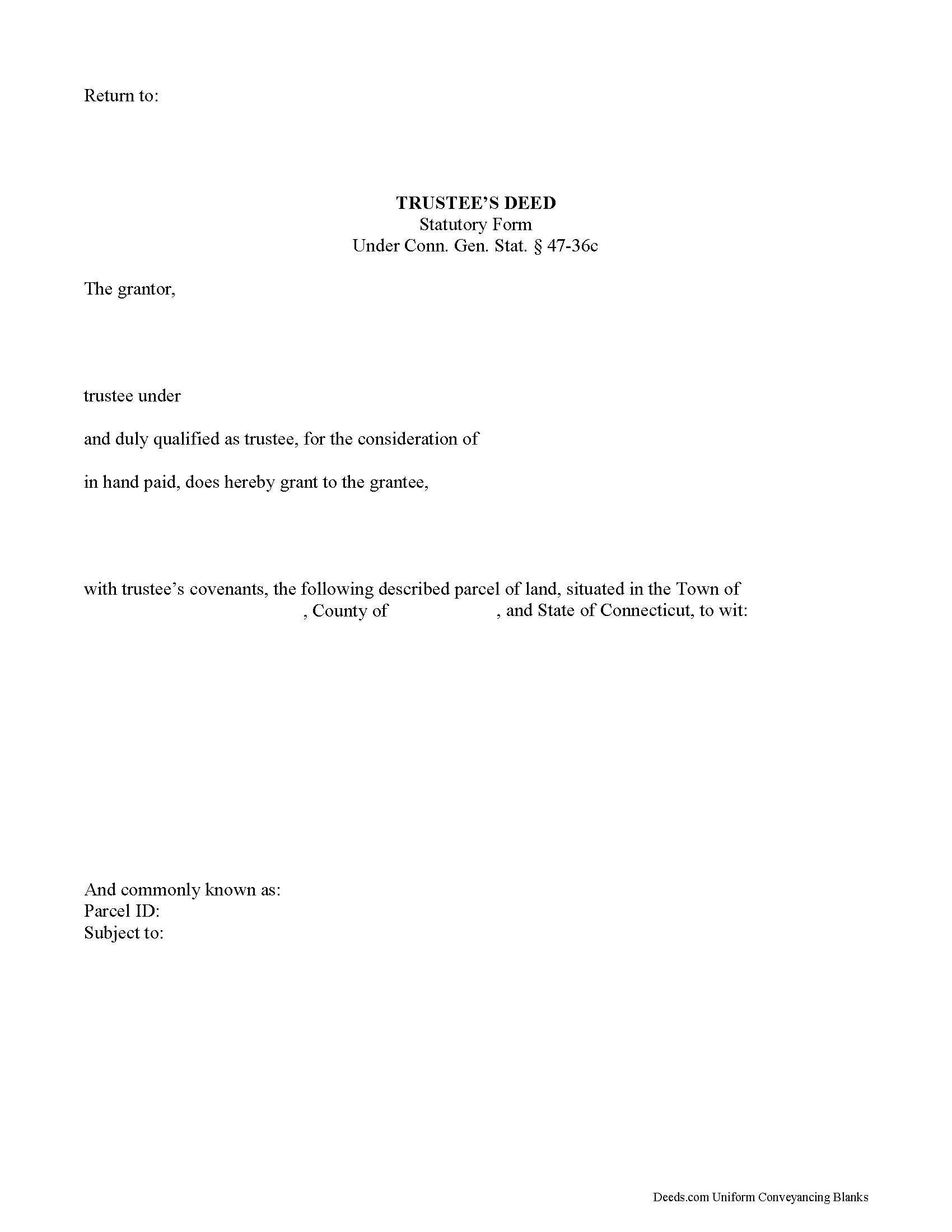
The trustee's deed is a statutory conveyance under Section 47-36c of the Connecticut Statutes. Unlike other forms of conveyance, it is named for the person executing the deed rather than the type of deed it is.
Used in trust administration, the trustee's deed conveys real property out of a trust. Since trusts cannot legally hold title to property in Connecticut, the trustee holds title to real property as a representative of the trust. The trustee must be authorized by the trust instrument to hold the position of trustee and to act on the trust's behalf.
A basic trustee's deed will name the trust's original trustee as the grantor and vest title in the name of a grantee. Sometimes, the grantor appears as a successor trustee if the original trustee is unavailable, due to death, for example. Documentation evidencing the change in trustee must be recorded in the town's land records.
When correctly executed, the trustee's deed grants title in fee simple to the grantee with the following trustee's covenants, pursuant to Sec. 47-36s of the Statutes: (1) the trustee is duly qualified to act as trustee, (2) the trustee has full power and authority as trustee to bargain and sell... More Information about the Connecticut Trustee Deed
Disclaimer of Interest
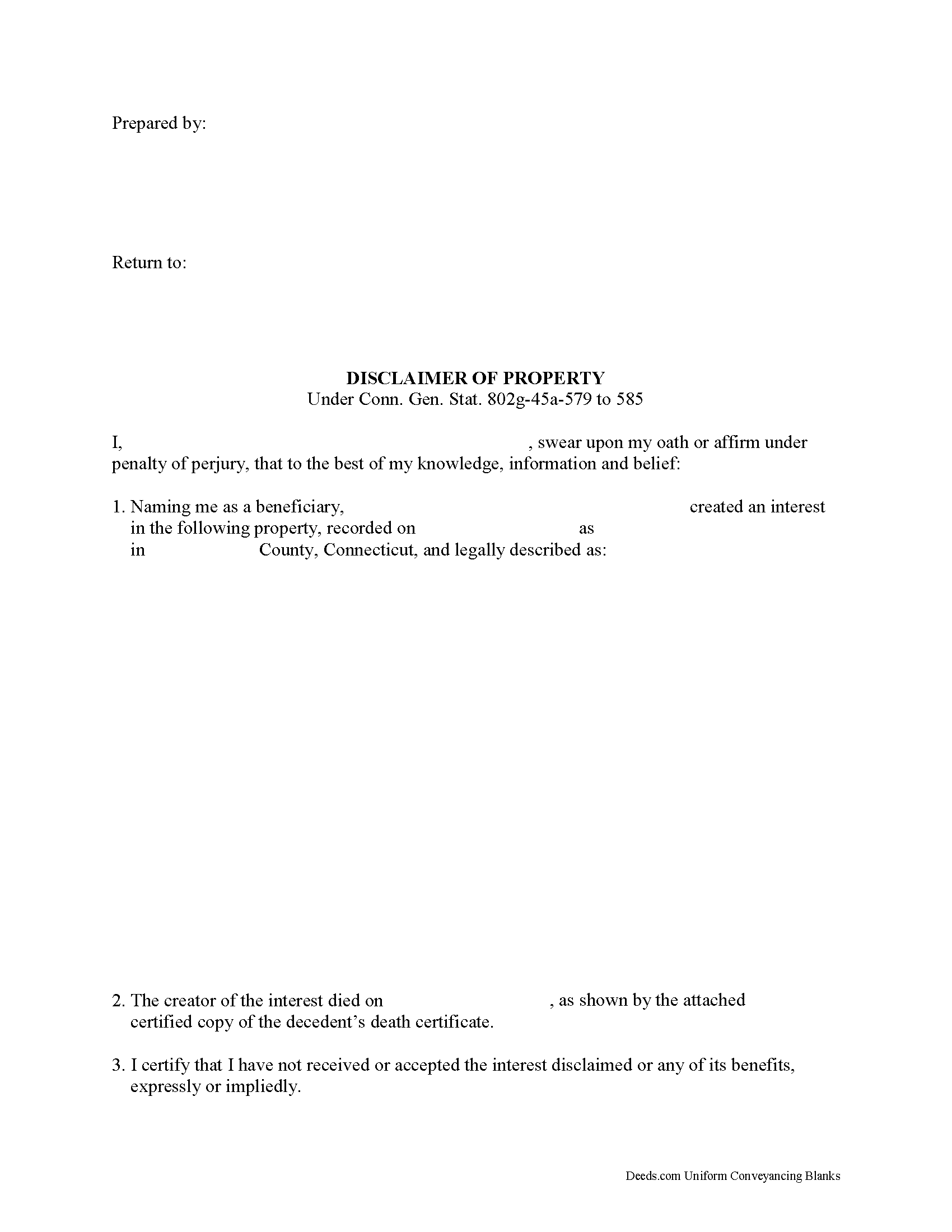
Under the Connecticut statutes, the beneficiary of an interest in property may renounce the gift, either in part or in full (General Statutes 802g-45a-578 to 590). Note that the option to disclaim is only available to beneficiaries who have not acted in any way to indicate acceptance or ownership of the interest.
The disclaimer must be in writing and include a description of the interest, a declaration of intent to disclaim all or a defined portion of the interest, and be signed by the disclaimant (802g-45a-579 & 583 (c)).
Deliver the disclaimer within nine months of the transfer (e.g., the death of the creator of the interest) to the legal representative of the decedent's estate, or with the probate court having jurisdiction over said estate (802g-45a-579 & 583 (d) (3)). In the case of real property, record a copy of the disclaimer in the office of the town clerk in the town in which the property is situated in order to make it effective against any person other than the disclaimant (802g-45a-579 & 583 (d) (4)).
A disclaimer is irrevocable and binding for the disclaiming party and his or her creditors, so be sure to consult an attorney when in doubt about the drawback... More Information about the Connecticut Disclaimer of Interest
Notice of Lis Pendens
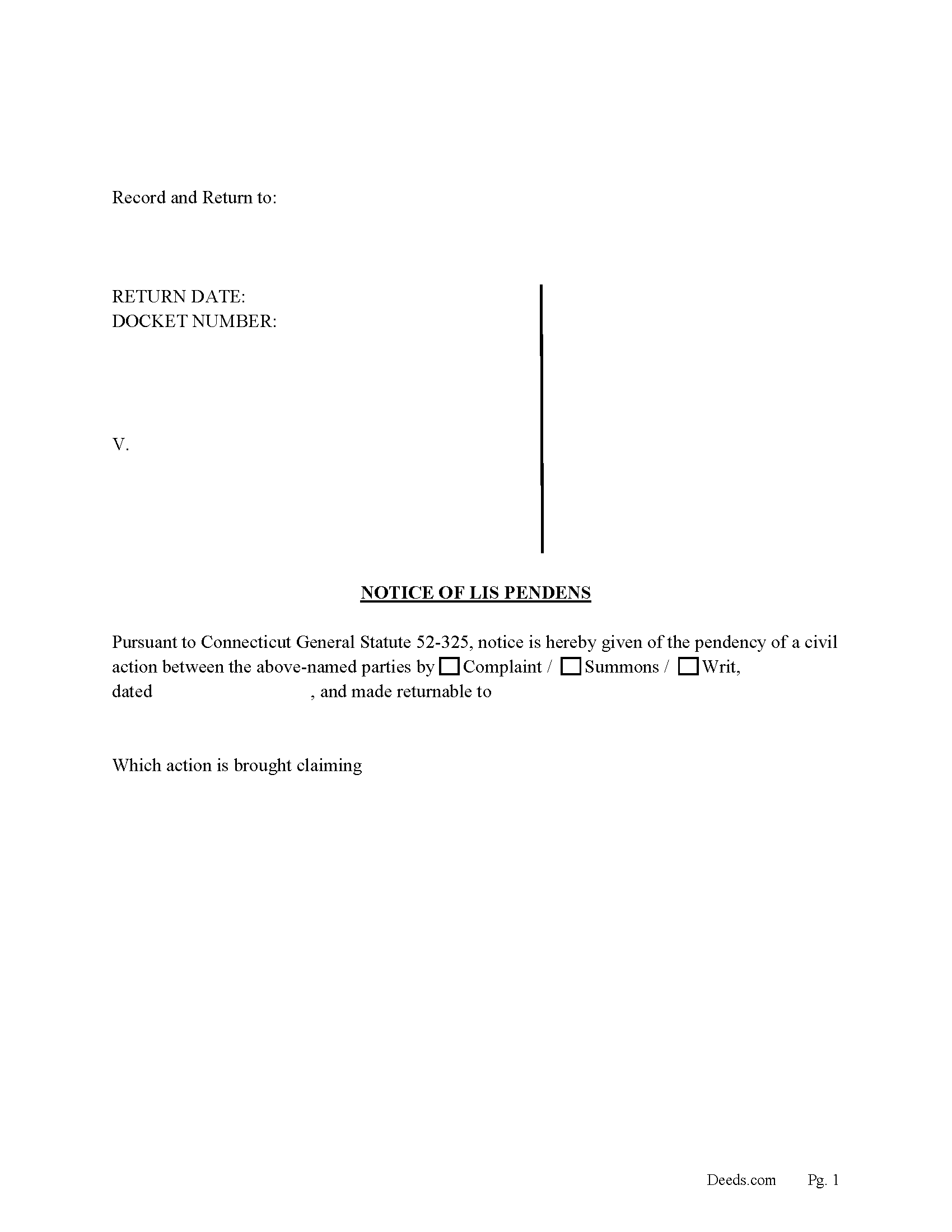
Pursuant to Connecticut General Statute 52-325, notice is hereby given of the pendency of a civil action. Use for a divorce, foreclosure of mortgage, quiet title action,foreclosure of a mechanic's Lien, etc
Once recorded:
SUCH NOTICE SHALL BE NOTICE TO ANY PERSON HERE AFTER ACQUIRING ANY INTEREST IN THE ABOVE-DESCRIBED PROPERTY OF THE PENDENCY OF THE AFOREMENTIONED ACTION AND CLAIM. EACH PERSON WHOSE CONVEYANCE OF ENCUMBRANCES SUBSEQUENTLY EXECUTED OR SUBSEQUENTLY RECORDED OR WHOSE INTEREST IS THEREAFTER OBTAINED BY DESCENT OR OTHERWISE, SHALL BE DEEMED A SUBSEQUENT PURCHASER OR ENCUMBRANCER AND SHALL BE BOUND BY ALL THE PRECEDING TAKEN AFTER THE RECORDING OF THIS NOTICE TO THE EXTENT AS IF HE/SHE/THEY WERE MADE A PARTY TO AFOREMENTIONED ACTION.
Included:
1- Notice of Lis Pendens
2- Lis Pendens Guide
3- Completed Example of Lis Pendens (Dissolution of Marriage)
4- Completed Example of Lis Pendens (Foreclosure)
5- Attestation of Lis Pendens Form (See C.G.S. 52-325(c)
6- Proof of Service by Disinterested Party (Plaintiff) ... More Information about the Connecticut Notice of Lis Pendens
Release of Lis Pendens
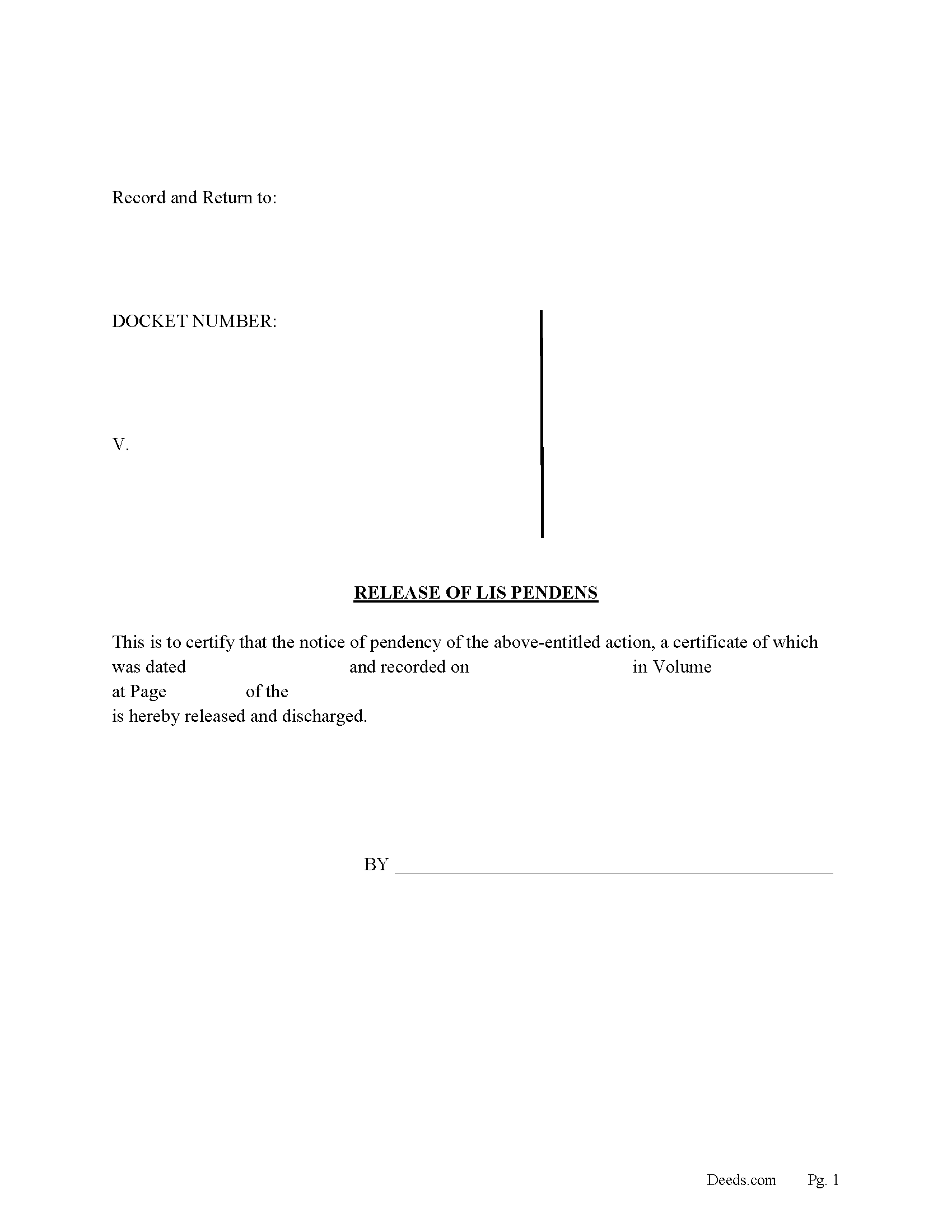
When a lis pendens is filed it provides constructive notice that a suit is pending, virtually making the property un-saleable. When the case is settled, or the claim has been satisfied by other means, it is imperative to record a "Release of Lis Pendens" and send a copy to all parties involved, avoiding a counterclaim. This form is used by the party who initiated the Notice of Lis Pendens, who wishes to voluntarily release it.
Included:
1- Release of Lis Pendens Form
2- Lis Pendens Guidelines
3- Completed Example
5- Attestation of Release of Lis Pendens Form (See C.G.S. 52-325(c)
6- Proof of Service by Disinterested Party (Plaintiff) ... More Information about the Connecticut Release of Lis Pendens
Mortgage Deed Form
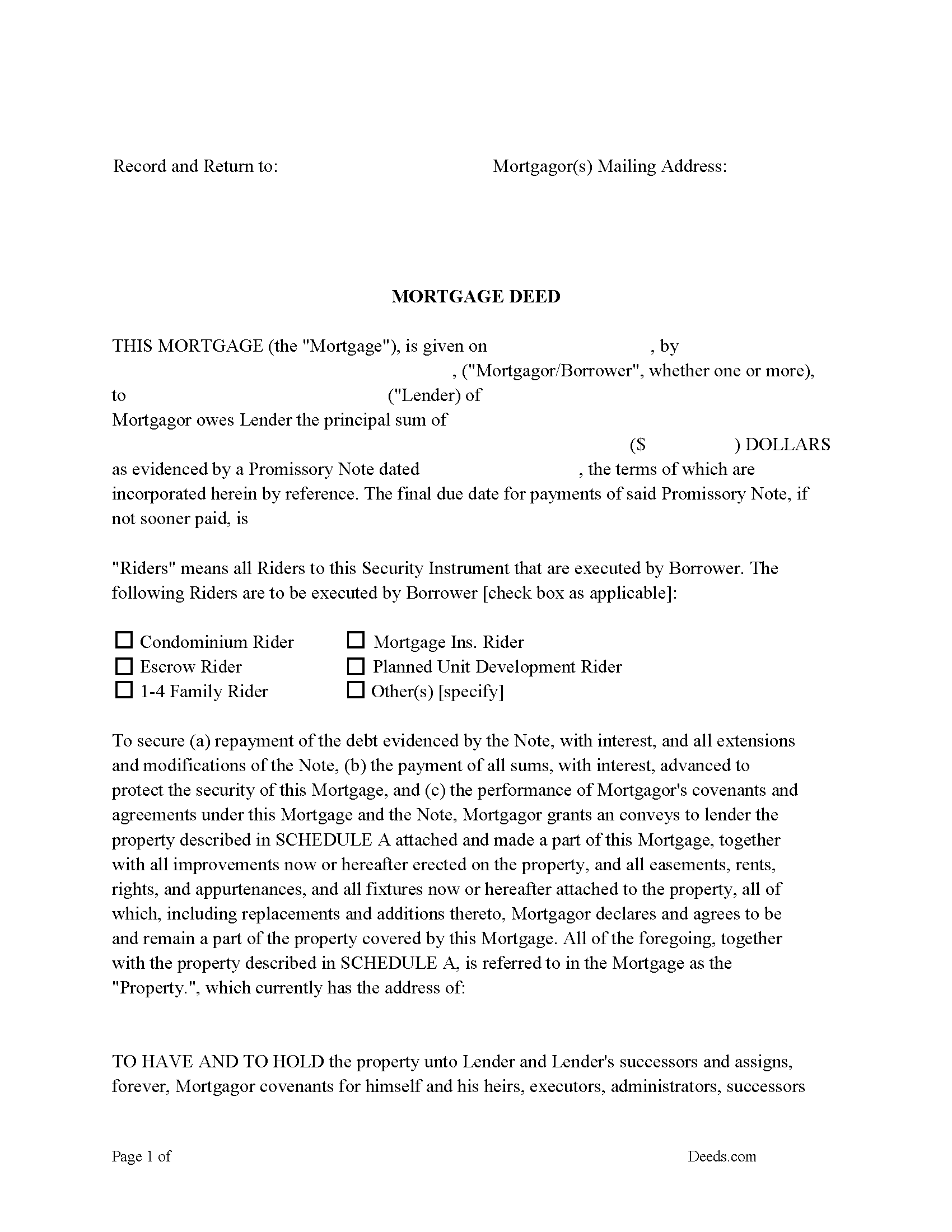
This is a Connecticut Mortgage Deed given to secure a debt on real property. This form can be used to finance a house, rental property (up to 4 units) or Condominium. This form secures repayment of a debt, with interest. evidenced by a Promissory Note. A Mortgage Deed with strong default clauses can be beneficial when selling and/or financing a property.
MORTGAGOR also known as BORROWER(S), WARRANTS AND COVENANTS AS FOLLOWS:
1. PROMISE TO PAY. Borrower shall pay the indebtedness evidenced by the Note and secured by this Mortgage.
2. CHARGES, LIENS, ESCROW. Borrower shall promptly pay all taxes, assessments, fines, impositions and other charges against the Property.
3. HAZARD INSURANCE AND CONDEMNATION. Borrower shall insure the Property against loss by fire, and such other hazards as Lender may require and in such amounts.
4. CONDOMINIUMS, PLANNED UNIT DEVELOPMENTS, COMMON INTEREST COMMUNITIES. If this Mortgage is on a unit in a condominium, a planned unit development or any common interest community (as that term is defined in Section 47-202(7) of the Connecticut General Statutes
5. PRESERVATION AND MAINTENANCE OF PROPERTY. Borrower shall maintain the property in g... More Information about the Connecticut Mortgage Deed Form
Release of Mortgage
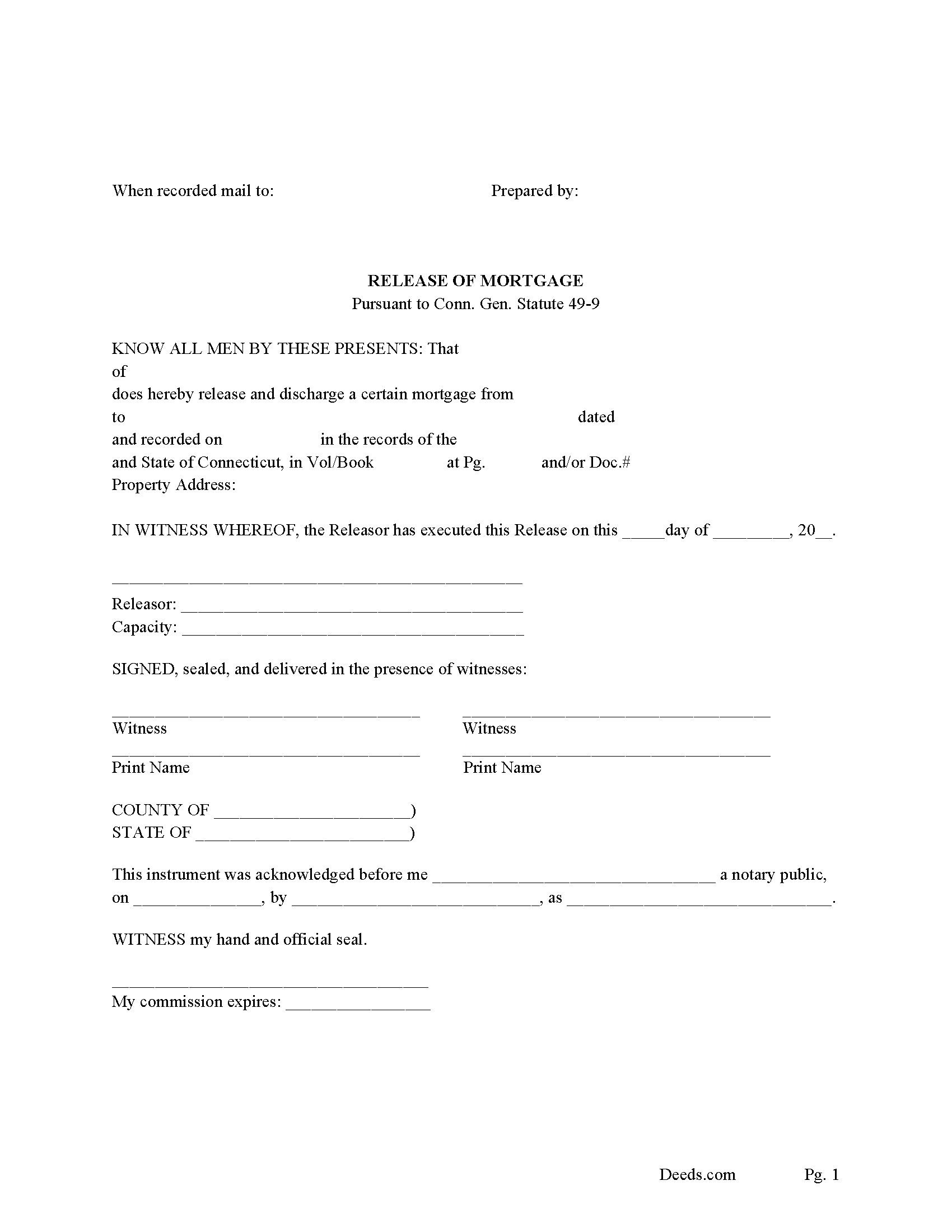
Once a loan on real property has been paid in full/satisfied the Lender/Mortgagee generally has 60 days to record a "Release of Mortgage" (also known as a "Satisfaction of Mortgage") and to notify the Borrower/Mortgagor of said action. If the satisfaction/release of mortgage is not given, the lender could be liable for damages. Once completed, submit this form to the town clerk who (shall index the affidavit in the name of the original mortgagee and the last assignee of the mortgage appearing of record as the grantors, and in the name of the mortgagors and the current record owner of the property as grantees.)( CT Gen Stat 49-8a(g))
A Connecticut "Release of Mortgage" shall state the names of the lenders and borrowers, (the date of the mortgage, and the volume and page of the land records where the mortgage is recorded. The affidavit shall provide similar information with respect to every recorded assignment of the mortgage.) (CT Gen Stat 49-8a(d))
This Form is made pursuant to (CT Gen Stat 49-9)
A mortgage of real or personal property, a mechanic's lien or a power of attorney for the conveyance of land may be released by an instrument in writing executed, attested and a... More Information about the Connecticut Release of Mortgage
Assignment of Mortgage
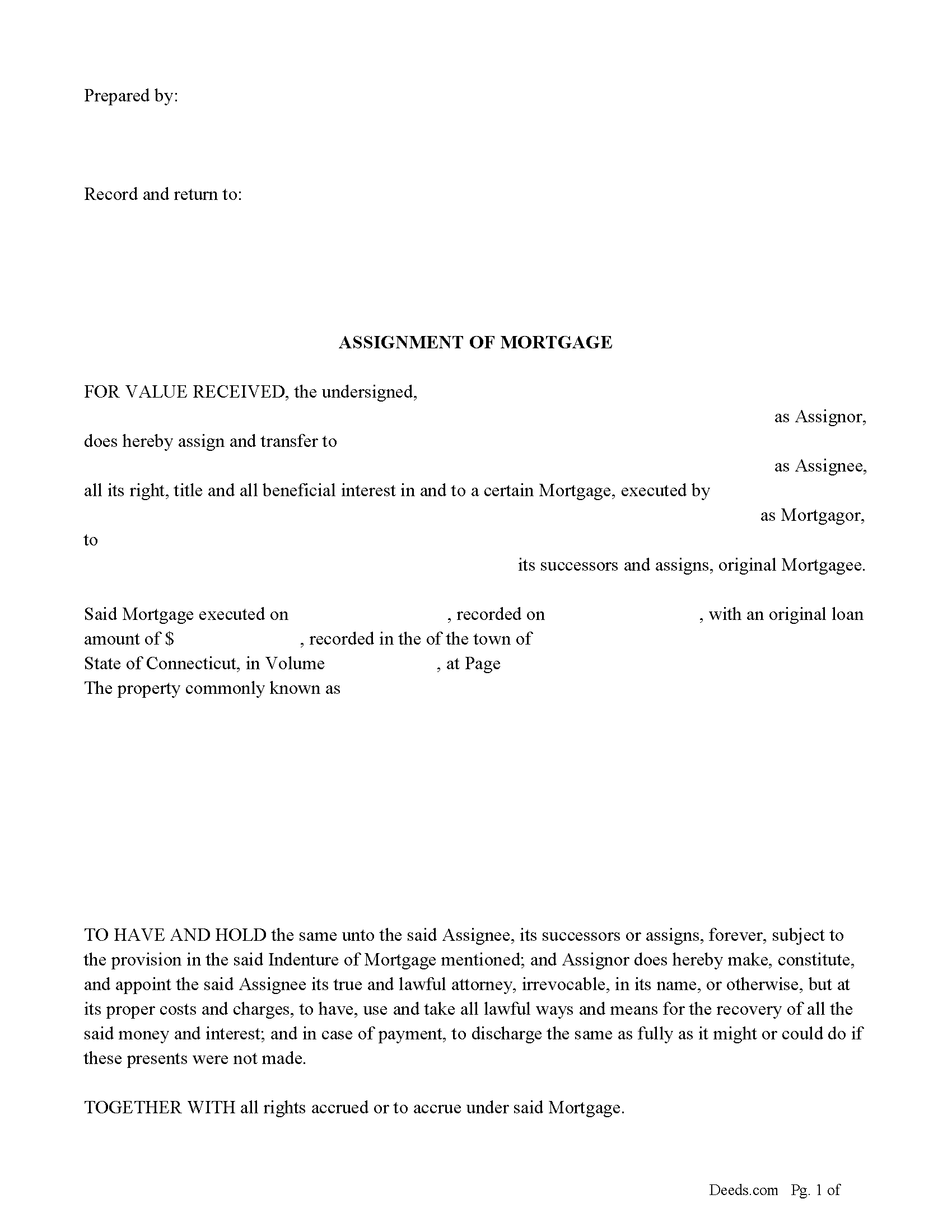
This form is used to assign ("mortgage debt" secured by mortgage) form the current lender to new creditor. (Sec. 49-10.(a))
(If a mortgage debt is assigned, a party obliged to pay such mortgage debt may discharge it, to the extent of the payment, by paying the assignor until the party obliged to pay receives sufficient notice in accordance with subsection (f) of this section that the mortgage debt has been assigned and that payment is to be made to the assignee. In addition to such notice, if requested by the party obliged to pay, the assignee shall furnish reasonable proof that the assignment has been made, and until the assignee does so, the party obliged to pay may pay the assignor. For purposes of this subsection, "reasonable proof" means (1) written notice of assignment signed by both the assignor and the assignee, (2) a copy of the assignment instrument, or (3) other proof of the assignment as agreed to by the party obliged to pay such mortgage debt.) (Sec. 49-10.(d))
Whenever any mortgage debt is assigned by an instrument in writing containing a sufficient description to identify the mortgage, assignment of rent or assignment of interest in a lease, given as security f... More Information about the Connecticut Assignment of Mortgage